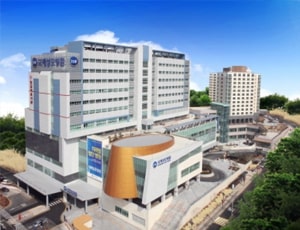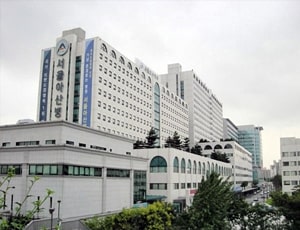The average cost of Angiography (Including Non-Ionic Contrast) in Seoul approximately starts from USD 3000
Treatment cost

International St. Mary's Hospital located in Seoul, South Korea is accredited by JCI. Also listed below are some of the most prominent infrastructural details:


Asan Medical Centre located in Seoul, South Korea is accredited by ISO. Also listed below are some of the most prominent infrastructural details:
Most physicians advise their patients to undergo the angiogram procedure (also known as angiography and arteriogram) when certain symptoms such as a heart attack or chest pain become a source of worry. A stress test is performed on patients who report chest pain, which is then followed by an angiogram test.
Angiography procedure aims at testing the blockages in the coronary arteries apart from any other cardiovascular-related ailments. Angiography and angiogram procedure can both locate narrowing arteries or blockages that may exist in different parts of the body.
Angiography is recommended for patients with coronary heart diseases (CHD), which can cause the heartbeat to stop suddenly and abruptly. The patient may also suffer from severe chest pain. Angiography can also be performed on patients on an emergency basis when they experience a heart attack. If the blockage is not treated immediately, then healthy tissues around the heart start perishing and turn into scar tissue. It can give rise to several long-lasting problems. Angiography may also be required in the case of a patient with aortic stenosis or those who have had an abnormal heart stress test.
The procedure involves administering a sedative for relaxation. An intravenous line is inserted into the vein. This is just a precautionary step to ensure that medication can be provided or blood products can be given in case of unwanted complications that take place during the angiography procedure.
The patient is kept under close observation for at least 6 to 12 hours if the procedure is performed on an outpatient basis. In case of a femoral artery puncture, the leg is almost kept immobile during the observation period.
Blood pressure and other vital signs are continuously monitored. A cold pack is applied to reduce swelling in the area of puncture and medications are given in case of extreme discomfort.
Hematoma may develop in a few patients. This indicates continuous bleeding from the puncture site and has to be watched for. Two to three days of complete rest is advised and driving should be avoided in the case of patients who have had fluorescein angiography. Direct exposure to sunlight should be avoided for at least 12 hours.
Ask your healthcare adviser for the best multiple options and choose the one that meets your expectations
Angiography (Including Non-Ionic Contrast) cost in Seoul starts from about $3000. Angiography (Including Non-Ionic Contrast) in Seoul is conducted across several KOIHA certified hospitals.
The cost of Angiography (Including Non-Ionic Contrast) in Seoul may differ from one medical facility to the other. The Angiography (Including Non-Ionic Contrast) package cost usually includes all the expenses related to pre and post surgery expenses of the patient. The treatment cost usually includes the expenses related to hospitalization, surgery, nursing, medicines, and anesthesia. There are many things that may increase the cost of Angiography (Including Non-Ionic Contrast) in Seoul, including prolonged hospital stay and complications after the procedure.
Angiography (Including Non-Ionic Contrast) in Seoul is offered by multiple hospitals across the country. Some of the most renowned hospitals for Angiography (Including Non-Ionic Contrast) in Seoul include the following:
The recovery of the patient many vary, depending on several factors. However, on an average, patient is supposed to stay for about 2 days in the country after discharge. This duration of stay is recommended to complete all the necessary follow-ups and control tests to ensure that the surgery was successful.
Apart from the cost of Angiography (Including Non-Ionic Contrast), the patient is also required to pay additionally for daily meals and guest house accommodation. These charges may vary from 40 USD per person.
The patient has to spend about 1 Days in the hospital after Angiography (Including Non-Ionic Contrast) for proper recovery and to get clearance for discharge. During the recovery, the patient is carefully monitored and control tests are performed to see that everything is okay. If required, physiotherapy sessions are also planned during recovery in hospital.
Out of all the hospitals in Seoul, there are about 2 Hospitals best hospitals for Angiography (Including Non-Ionic Contrast) in Seoul. These hospitals have the required infrastructure and a decided Angiography (Including Non-Ionic Contrast) unit where renal failure patients can be treated. Additionally, these hospitals are known to comply with the international standards as well as local legal requirements for the treatment of patients.
Some of the most sought after doctors for Angiography (Including Non-Ionic Contrast) in Seoul are: